Lloyd Sabaudo Line's Progress - New Palatial Steamships Tomaso di Savoia and Principe di Udine
Lloyd Sabaudo Line's Progress
Popular Italian Steamship Comnan y Possesses Large Fleet of Passenger and Cargo Vessels—Description of the "Conte Rosso," Latest Addition to the Number
MANY points of historical interest have recently been brought to light regarding the Lloyd Sabaudo Line by the attention it has received on account of its fine new passenger vessel, the Conte Rosso, soon to arrive at New York on her maiden trip.
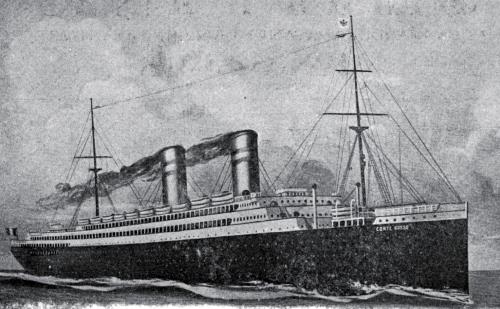
THE NEW PALATIAL STEAMSHIP "CONTE ROSSO," 21,000 TONS DISPLACEMENT, NAMED AFTER THE "RED COUNT" OF LEGENDARY FAME
The Lloyd Sabaudo Line was organized in Turin, Italy, on June 21, 1906, with head offices at Genoa. On April 7, 1907, the company celebrated the inauguration of its services by despatching from Genoa the Re D'Italia on her maiden trip to New York. There followed other steamers, namely, the Regina D'Italia, Principe Di Piemonte, Principe Di Udine and Tomaso Di Savoia, the latter two having been later assigned to the South American trade with success.
In 1914 the line purchased thirteen freight units, forming a powerful commercial fleet which, during the war period, had particular importance. The company has been making consistent strides in the commercial field and at present owns a fleet of passenger and cargo vessels of a total displacement of about 200,000 tons operating in the following services:
- Italy—North America
- Italy—South America
- Italy—North Europe
- Italy—North America—Levant
- North Europe—Italy—Australia
The steamers of the line rendered conspicuous service during the World War, serving as hospital ships, transports of allied troops to and from the War Zone and the American troops from Newport News; also transporting provisions, cattle and ammunition from the United States to France and returning a considerable number of the American Expeditionary Forces to the United States.
The New Liner "Conte Rosso"
Conte Rosso, the "Red Count" of legendary fame, recalling to our vision the stalwart figure of that wise and valiant seigneur of Savoy, whose mind and sword wrought the early fortunes of the ancient dynasty, is the name now proudly borne by a superb ocean liner, the latest addition to the Lloyd Sabaudo fleet.
In England, the Conte Rosso has been characterized as "excelling all liners laid down since the war both in speed and in the luxury of her passenger accommodation." She has been constructed in the yards of William Beardmore at Dalmuir, Scotland, and has a length of 590 feet. a beam of 74 feet and a gross tonnage of 18,500 tons, with passenger capacity for 500 cabin and 1,500 steerage: also cargo space for 1.500 tons D. \V., and a commercial refrigerator of 500 tons capacity. She is an oil burner of 18.500 horsepower. which will drive her at 20 knots, and will be able to make the trip from New York to Genoa in less than nine days.
The eight cylindrical boilers are liquid fuel or coal; the alternative choice is simply precautional, as the steamer will use naphtha of which she has reservoir capacity of 3,500 tons, a quantity amply sufficient to ensure complete independence from intermediate ports. To all those who have experienced the nuisance of coaling en route, especially in hot climates, this will be an appreciable relief. Coal dust, cinders and soot have become a thing of the past.
The steamer is scheduled to arrive at New York on February 24, and is due to sail from thence on March 4 for Naples and Genoa.
Security of Life at Sea
A notable feature of the liner is the perfection of the arrangements for the security of life at sea. No scientific device, no approved contrivance is lacking for that purpose, and it is well worth while to make a brief description of the principal ones.
There are nine main watertight bulkheads which section the hull from keel to shelter deck, provided with a strictly limited number of automatic doors which can be shut locally and from other points of the ship; an ingenious apparatus also allows these doors to be shut severally or all together from the bridge. There are other secondary metallic divisions to ensure immediate isolation in case of fire, as well as an unusually large number of hydrants for its rapid extinction.
The steamer has a double bottom throughout its entire length, partitioned in fifty-one sections. The life- boats, of which there are more than enough for every soul on board, can be put to sea in pairs, with great safety and despatch. One of the largest lifeboats is run by motor and is fitted with a complete wireless apparatus with a radius-power of fifty miles.
The wireless plant on the steamer is of the latest powerful type (KW 1, 5), and is noiseless and non-vibrating. Every one is aware that, thanks to Guglielmo Marconi, besides telegraphy, another means of communi cation which is making long strides towards perfection and everyday use is the long-distance wireless telephone. The steamer is also fitted with this device, thus ensuring a quicker intercourse with other vessels and land stations.
Submarine signalling also adds to the safety of the vessel. When thick weather shrouds the field of vision, the sound vibrations through the microphone will acquaint attentive ears on board of the vicinity of other ships and also confirm the right course near certain land points.
Many Modern Features
The nautical man who knows about the "vexata quaestio" concerning the needle will be interested to learn that the vessel, besides the ordinary magnetical compasses. is fitted with Sperry's ship-compass, which ensures the steadiest course.
Among the maze of subsidiary machinery, the electric lighting plant is worthy of a special note for its unusual power. It is composed of three turbo-generators of 150 Kw each, besides an emergency 35 Kw dynamo, which is driven independently by a special oil-motor. Part of the various electrical appliances is a very useful telephone connection throughout the boat.
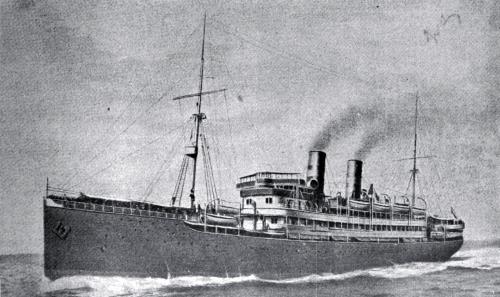
THE FAST DE LUXE TWIN-SCREW STEAMSHIPS "TOMASO DI SAVOIA" AND "PRINCIPE DI UDINE," OPERATING IN THE ITALY-SOUTH AMERICA TRADE
Needless to say, the hydraulic and sanitary arrangemetts are perfection itself. The vessel is lavishly supplied with fresh water out of huge tanks of an aggregate capacity of 1,000 tons; before reaching the taps, this water is run through an elaborate system of filters which render it absolutely pure.
In the warm season, the water is also cooled by circulation in a special refrigerating plant. Furthermore a large distilling plant is capable of supplying a further 50,000 liters of fresh water per diem. The refrigerating plant consists of two sets of Hall machines, to maintain a low temperature in 12,000 cubic feet of store rooms and 21,000 cubic feet cargo holds.
The hospitals and surgery for this floating town are up-to-date models of the kind, perfectly equipped, and answering every modern requirement of science.
Last but not least, the kitchens are such as both the hygienist and the exacting bonne menagere could find no fault with.
The places where the gourmet is catered for are located high on the upper decks in order to keep their heat out of the dining saloons and staterooms. A large steam-laundry is also provided for the use of passengers. There are barber shops supplied with all the modern paraphernalia.
Luxurious Passenger Accommodation
Let us now emerge from the summary of "technicalities" and bestow a glance at the passenger's accommodations. Here, Italian artists and experts have each lent their genius and experience to transform the grim machine into a fairy palace of comfort and luxury.
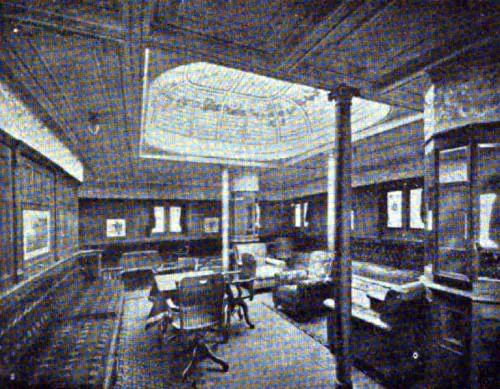
FIRST CLASS SMOKING ROOM—"TOMASO DI SAVOIA" AND "PRINCIPE DI UDINE"
"Luxurious" is an adjective used so lavishly nowadays, that it can hardly convey an adequate idea of the charming and restful environment on the Conte Rosso; it may be truly said that the refined taste of the pure Italian art eclipses any decorative scheme elaborated hitherto. No ornamental congestion, no strident contrasts, but the quiet. harmonious ensemble which delights the discriminating connoisseur.
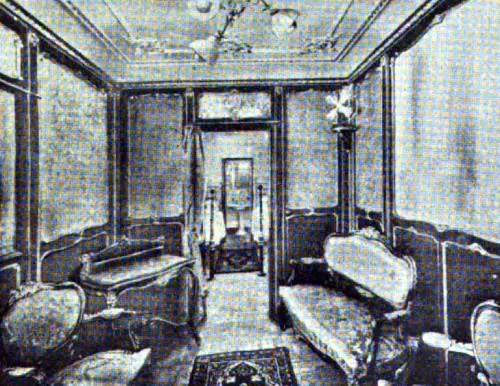
FIRST CLASS APARTMENT De LUXE "TOMASO DI SAVOIA" AND "PRINCIPE DI UDINE"
A most striking feature everywhere is the great spaciousness. achieved at the cost of reducing the berth ing capacity of the vessel; the designers of the Conte Rosso were bent upon relieving that peculiar feeling of confinement so common to people on a ship, and have been remarkably successful in this task.
The sumptuousness and airiness, rather than conveying the idea of a tiptop hotel, recall to one's mind the interior of some magnificent patrician palace. The lofty public rooms, entrance halls, dining saloons, music, reading, writing and smoking rooms are each worth a description for which these abridged notes can hardly suffice.
Honoris Causam
Let us not omit to devote a word of appreciation for this remarkable achievement in the history of shipbuilding and art to those who moulded the mass of steel into shape and power and to the others who gave it grace and beauty. Among the latter, in bold relief stands the work of Mariano Coppede and his brother, whose fertile brains lavished their artistic genius in the creation of masterpieces of decorative art; also Luigi Cavalieri, the well-known painter of Florence, whose brush has enlivened the dining saloon with magnificent paintings.
Synopsis of Decorative Scheme
The style for the various public rooms is well chosen to harmonize with the character of each one. In fact, the modern style nicely befits the veranda-cafe, as the spacious halls with the busy lifts endow the place with quite an up-to-date aspect while earlier styles best suit the remainder.
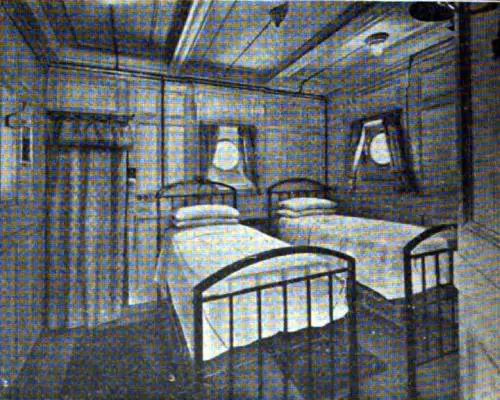
FIRST CLASS STATEROOM WITH PRIVATE BATH-"TOMASO DI SAVOIA" AND "PRINCIPE DI UDINE"
The elegant simplicity of the veranda café is a charming product of modern comfort. It is finished in ashwood and daintily decorated.
The grand halls are panelled in mahogany and oak in tasteful proportion with a wealth of artistic wood sculptures and inlaid work picked out in maple. The lower hall is connected with the upper by a grand staircase of the same material, a specimen of skilled workmanship. Both halls are illuminated through a large stained glass dome supported by a series of slender columns. Light at night is supplied by a magnificent bronze lampholder.
.The decoration of the dining saloon and lounge above it is inspired by the style of the XV Century—massive and severe for the lower saloon—lighter and influenced by later developments of the same style for the lounge. Both are finished in solid oak, with embossed leather panels and sumptuously furnished to match. The tall sideboards are a unique reproduction of furniture of that period, with elaborated sculptures, carvings and other ornaments.
The classic Roman-Pompeian style with its pure graceful lines, dainty ornaments and alternate gilt and colored mouldings, is verily appropriate for the music and dancing saloon. The centre of this saloon is a slightly raised platform supported by beautiful Ionic columns, an ideal structure for concerts and balls.
The large French mirrors, antique vases, stained glass windows and dome, the rich tapestry and furniture, recall to one's fancy all the grandeur of those wonderful saloons de fetes in some famous old Venetian palace.
The smoking room has drawn its decoration from the Oriental style, bizarre and light—revelling in rich lines and intricacy of design, quaintly expressive of the ancient East.
The Florentine renaissance reigns quiet. severe and beautifully plain in the library and the writing room. Both are finished in old nutwood and furnished in a highly comfortable way. A large bay window admits plenty of daylight. Worthy of notice the handsome wrought iron lamps. These two rooms are exquisitely expressive of repose and meditation. Art and comfort could not be more perfectly blended than they are in this intellectual refuge.
The Red Count Depicted
Various episodes of the life of Amadeus VII, the "Red Count." so called after the color of the garments he sometimes wore on the field and in the lists—are depicted on domes and panels, together with coat-of-arms and emblematic particulars: an estimable collection of art. Rich carved woodwork, bronze mouldings, beautiful tainted panels, dainty bas-relief, etc. meet the pleased eye everywhere.
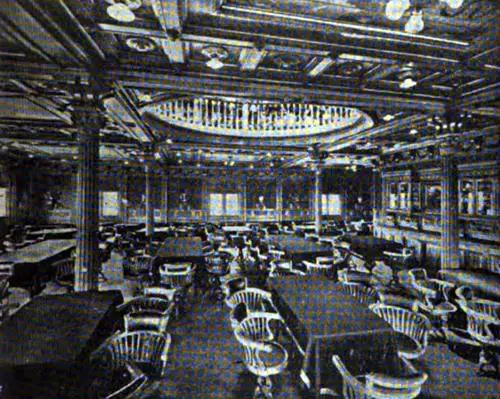
FIRST CLASS DINING SALOON-"TOMASO DI SAVOIA" AND "PRINCIPE DI UDINE"
The magnificently appointed staterooms are a further example of spaciousness. It will suffice to mention that the de luxe apartments are 13 x 23 feet. and the two-bedded cabins 10 x 11 feet. etc. The height is generally from eight to nine feet. Each cabin has running hot and cold water, electric fans, low-pressure steam heat. and capacious wardrobes. There are no superpoised berths on Deck B. C and D in first class: each room has one or two comfortable modern bedsteads.
Enormous Deck Space
The balmy southern route undoubtedly encourages life in the open air and few steamers provide an equal amount of unencumbered open and sheltered deck space for promenades and amusements. Figures are arid but best convey-the exact idea: 15,553 square feet of deck space are reserved for sa!oon passengers and 11,733 for second cabin.
The narrowest breadth of the deck is slightly over thirteen feet and five complete rounds on it are 1,635 yards, something more than a statute mi e The outdoor enthusiast and juvenile society will find plenty of deck games on board to beguile the hour, while the sedate seniors will agree that the spacious veranda affords delicious nooks of rest for open-air loungers.
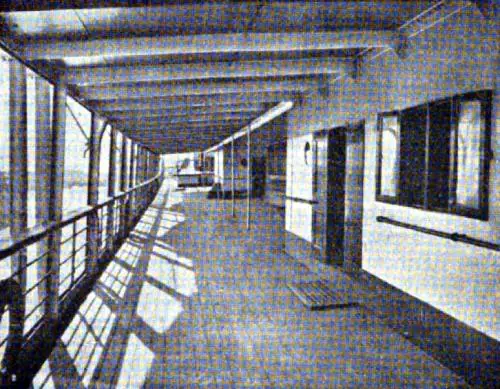
SPACIOUS PROMENADE DECK--"TOMASO DI SAVOIA" AND "PRINCIPE DI UDINE"
Open-Air Restaurant
A pleasant novelty for the warm, calm months will delight everyone, but particularly those who, not being wholly what are called "tars," dread indoors at dinner time, i. e. the forward part of the main promenade is fitted to be transformed into an open-air restaurant capable of accommodating all the passengers.
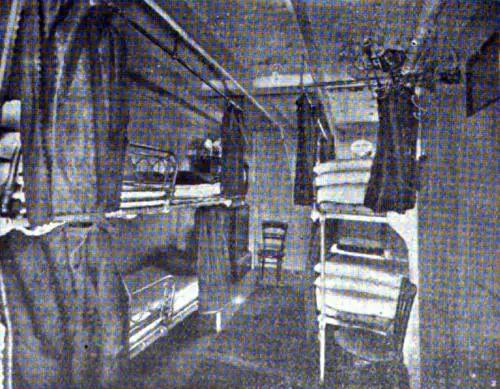
SECOND CLASS FOUR BERTHED CABIN-"TOMASO DI SAVOIA" AND "PRINCIPE DI UDINE"
The broad, artistic stairways are not the only medium of communication from one deck to the other, for roomy electric elevators rapidly transfer passengers up and
down, thus removing the somewhat objectionable climbing, a feat which few relish, especially in rough weather.
The plainer requirements of second Cabin and third class passengers are also adequately pre ided for. Clean spacious quarters. good wholesome fare and abundant airing deck space will make them highly pleased with the boat and her service. The second cabin on the Conte Rosso is every bit as good as the first on many other boats, whilst the third is also remarkably improved.
In.1923 a sister ship, the Conte Verde, now in the course of construction in the same yards at Scotland, will be put into service, thus assuring to the Lloyd Sabaudo the supremacy of the lines operating in the Mediterranean service.
Colonel Dr. M. Serrati
Colonel Dr. M. Serrati, for many years Italian Commissioner of Emigration in New York and an internationally known authority on emigration matters, is general agent of the line for the United States, and Canada, with offices at 44 Whitehall street and 3 State street, New York, while Furness, Withy & Company,. from whose pier at the foot of West Fifty-fifth street. New York, the steamers of the Lloyd Sabaudo sail, handle the freight traffic.
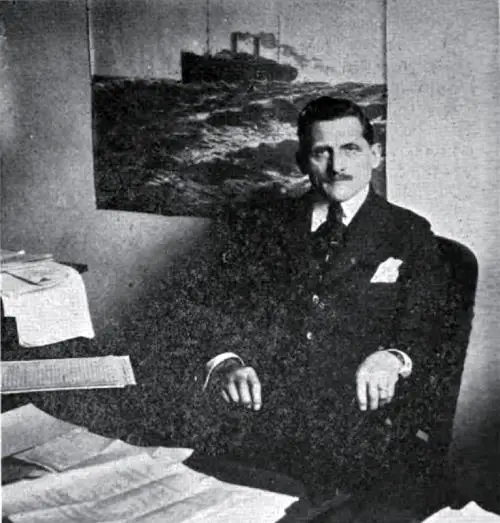
COLONEL DR. M. SERRATI -- General Agent for the U.S. and Canada
Dr. M. Serrati has been an officer in the Royal Italian Navy. retiring in 1920 with the rank of Colonel after twenty-five years of distinguished service and is "expert" on laws governing the fitting of vessels for the proper transportation of passengers. The later ten years of his career, he spent in the various ports of the United States acting in the capacity of Italian Commissioner of Immigration in the service of the Italian Embassy and Italian Consulates.
Since June. 1920, he has been at the head of the New York Agency of the Lloyd Sabaudo Line. His connection with the Line has greatly added to its prestige and it is largely through his influence that the Directors of the company in Genoa aged to placing the new De Luxe steamer "Conte ROSSO" on the North American route.
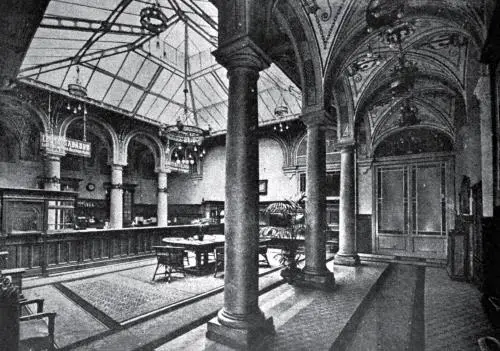
LLOYD SABAUDO BOOKING OFFICE AT GENOA
Source: Shipping Magazine, 10 February 1922
